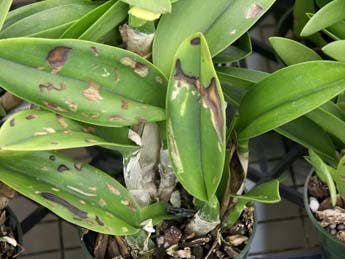
Mesophyll Cell Collapse


Gallery

Prevention
Since nothing can be done to reverse this damage once it has occurred, the emphasis is on prevention rather than a cure. One of the biggest precautions growers may take to avoid possible damage is to make certain that all water coming in contact with the plants is at or above 50° F (10° C), it is within at least 25° F (4° C) of the leaf temperature and would match that of the ambient temperature in the growing area (also at or above 50° F [10° C]). One convenient tool for monitoring and maintaining ideal water temperature is a faucet attachment that contains a thermometer, such as those used in bathroom showerheads that continuously adjusts the water flow to a preset temperature. Another option is to allow the water to sit in the growing area until it has reached ambient temperature before being used on the orchids
In addition, extra protection from cold temperatures, for example heaters in the growing area and protection from cold winds (wind chill below 50° F [10° C]) can also help prevent this type of disfigurement.
Additional Information
By Susan Jones
The most sensitive to mesophyll cell collapse are developing leaves, especially in phalaenopsis. These may show signs of damage after two hours at 45° F (8° C). At lower temperatures, the symptoms become more severe with shorter exposure. However, a phalaenopsis with all mature leaves may withstand up to eight hours at 35° F (2° C) without any problems.
Further Reading
Curry, Robert Doyle. 1975. Mesophyll Collapse in Phalaenopsis. AOS Bulletin 44(6):497.
Neufeldt, Victoria, and David B. Guralnik, Editors. 1994. Webster’s New World Dictionary. Prentice Hall, New York.
Poot, Inge. 2003. “Inge’s January 2003 Programme Notes.” Southern Ontario Orchid Society.
Sheehan, Thomas J.1995. “Physiological Diseases of Orchids.” In Orchid Pests and Diseases. American Orchid Society, Delray Beach.
—. 1987. Question Box. AOS Bulletin 56(7):733.
Susan Jones was the editor of Awards Quarterly and assistant editor of Orchids. American Orchid Society, 16700 AOS Lane, Delray Beach, Florida 33446
All reuse must contain the following:
Reprinted from the SEPTEMBER 2003 issue of Orchids -- The Bulletin of the American Orchid Society. Copyright American Orchid Society -- www.aos.org
Causes
Mesophyll is the soft tissue inside a leaf, between the lower epidermis and the upper, chiefly concerned in photosynthesis. It is also called green parenchyma; this is a soft tissue made up of thin-walled, undifferentiated living cells with air spaces between them, the primary substance of plant leaves, roots, and the central portion of stems.
Mesophyll collapse can occur if orchids are exposed to very low air or water temperatures, which usually occurs on the coldest nights. Low water temperature (35° to 45° F; 2° to 8° C), or water that is more than 25° F (4° C) lower in temperature than the plant’s leaves, can cause the mesophyll cells to collapse. Watering, spraying or overhead misting of plants with cold water, or even cold condensation falling onto leaves can cause this problem. As most growers do not see the symptoms until weeks after they have occurred, it can be difficult to relate them to cold damage.
Is it Mesophyll Cell Collapse?
If you suspect a plant is suffering from mesophyll cell collapse, a quick but careful inspection can help to confirm or rule out this diagnosis. Check not only the affected plant, but the entire collection, especially the surrounding plants.
-- Thrips can cause damage to orchid plants that is similar in appearance to mesophyll cell collapse. Inspect affected plants carefully for thrips or their eggs, which are normally laid just under the upper epidermis of the leaf.
-- Rule out the possibility of chemical damage by checking each chemical used for dosage and compatibility. Make certain that the chemicals used are labeled as safe for orchids, and that the recommended dosage has not been exceeded.
-- Although it may appear similar at first glance, mesophyll cell collapse can be distinguished from virus problems in that it occurs mainly on developing leaves and is usually evident on only one or two of the new leaves. The next leaf produced should appear normal.
-- Eliminate sudden changes in the growing environment or cultural routine as a possible cause of disfigured leaves.
-- Even after a diagnosis of mesophyll cell collapse has been reached, it is advisable to keep all damaged plants segregated and under close observation for four to six weeks.

FREE ACCESS: Orchid DealWire
Get notified when orchid vendors have special promotions and exclusive savings.







